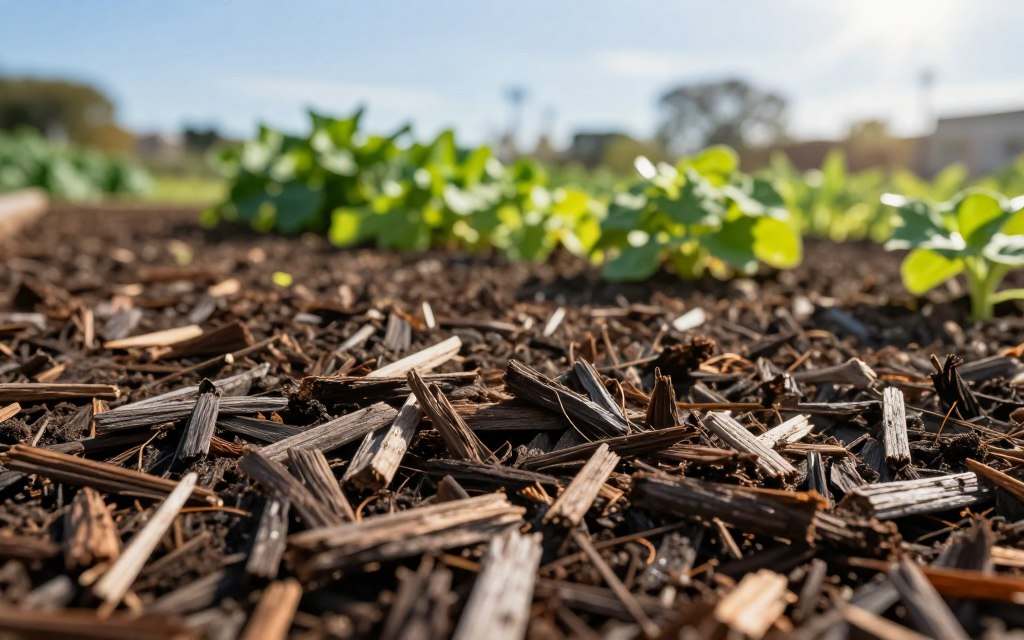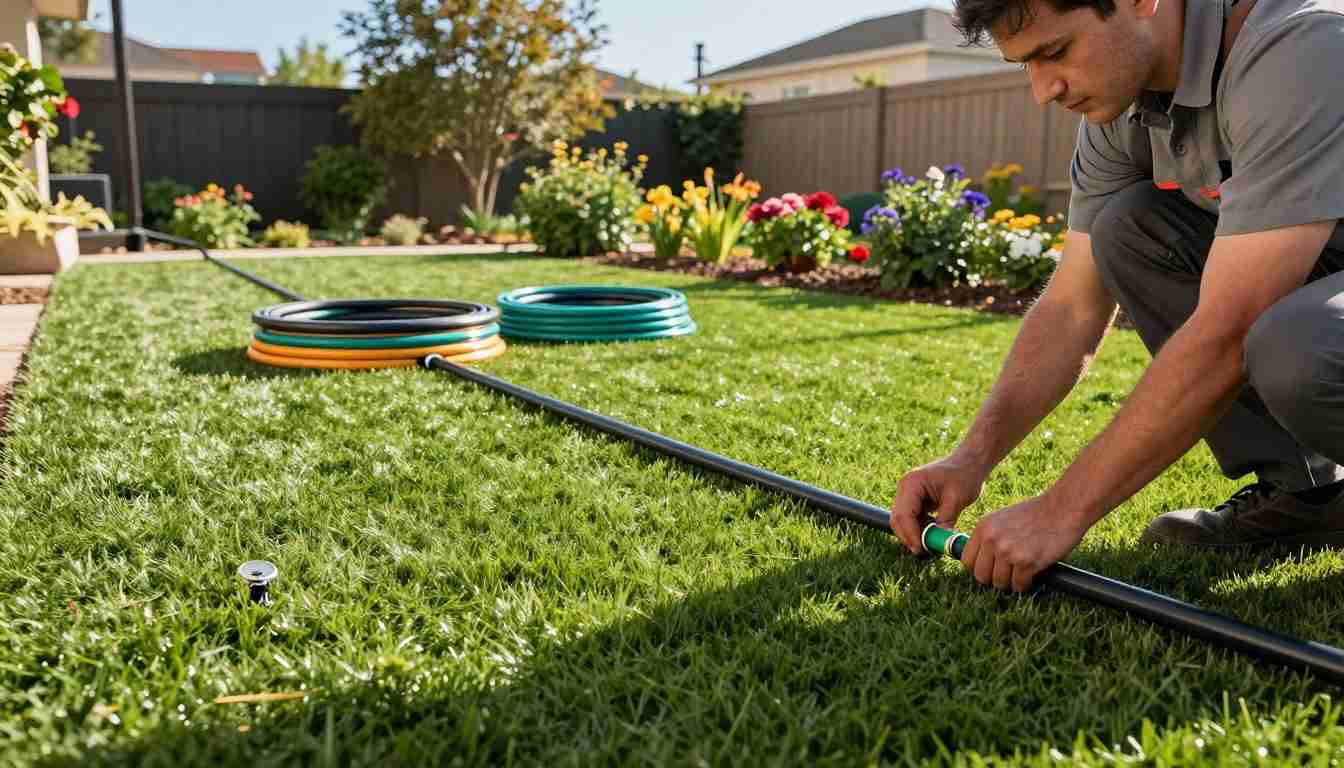Your lawn will show distinct signs when it needs fertilizer, including stunted grass growth, poor recovery after mowing, and yellow or brown patches from nitrogen deficiency. You’ll notice thinning areas with visible soil, along with increased weed invasion as grass becomes too weak to compete. Look for dull coloration instead of vibrant green and minimal vertical growth between cuts. A soil test can precisely identify your lawn’s specific nutrient requirements for ideal health.
Signs of Slow or Stunted Grass Growth
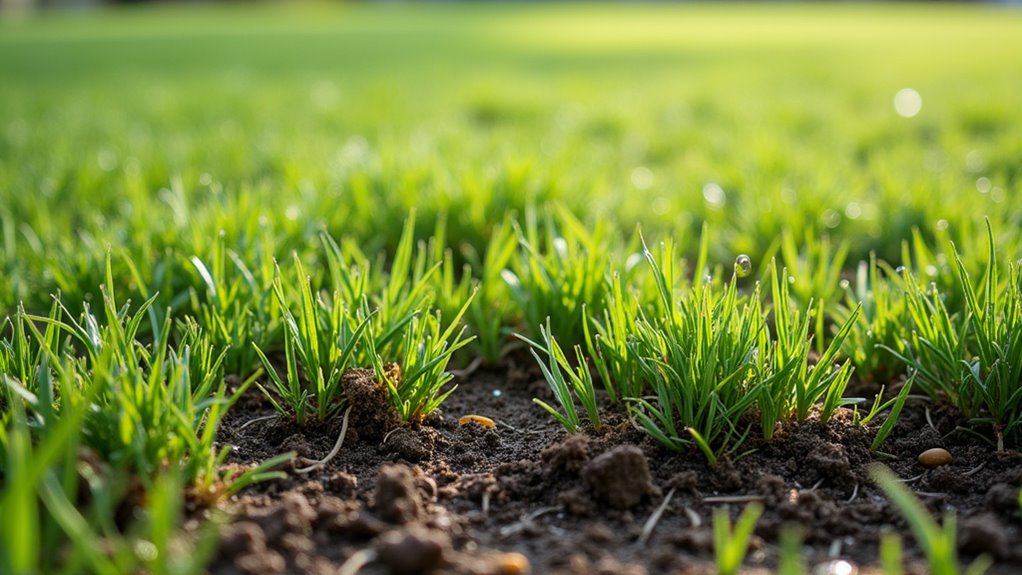
When your lawn isn’t growing at its typical rate of up to an inch per week, it’s likely suffering from nutrient deficiency. You’ll notice this slow growth pattern particularly when your grass fails to bounce back after mowing or shows minimal vertical development between cuts.
Your lawn requires essential nutrients like nitrogen, phosphorus, and potassium to maintain healthy growth rates. Without these crucial elements, grass plants can’t produce sufficient chlorophyll or generate the energy needed for effective development. If you’re observing stunted growth patterns, it’s time to evaluate your lawn’s fertilization needs.
Monitor your grass’s weekly growth rate carefully. When you notice consistent slow growth despite adequate water and sunlight, it’s a clear indicator that your lawn needs a properly balanced fertilizer to restore preferred nutrient levels and growth patterns.
Changes in Lawn Color and Appearance
The most visible sign of a nutrient-deficient lawn appears in its color changes. When your grass lacks essential nutrients, particularly nitrogen, you’ll notice distinct shifts in its appearance that indicate it’s time to fertilize.
Watch for these critical color and appearance indicators:
- Yellow or brown patches developing across your lawn, signaling insufficient nitrogen for proper chlorophyll production
- Uneven coloration throughout the turf, suggesting varying levels of nutrient deficiency in different soil areas
- Thinning grass with visible bare spots, indicating the soil can’t support healthy growth
- Comprehensive dull appearance rather than a vibrant green hue, pointing to depleted nutrients in your soil
These visual cues, combined with proper soil testing, will help you determine when your lawn needs fertilization to restore its health and appearance.
Increasing Weed and Pest Problems
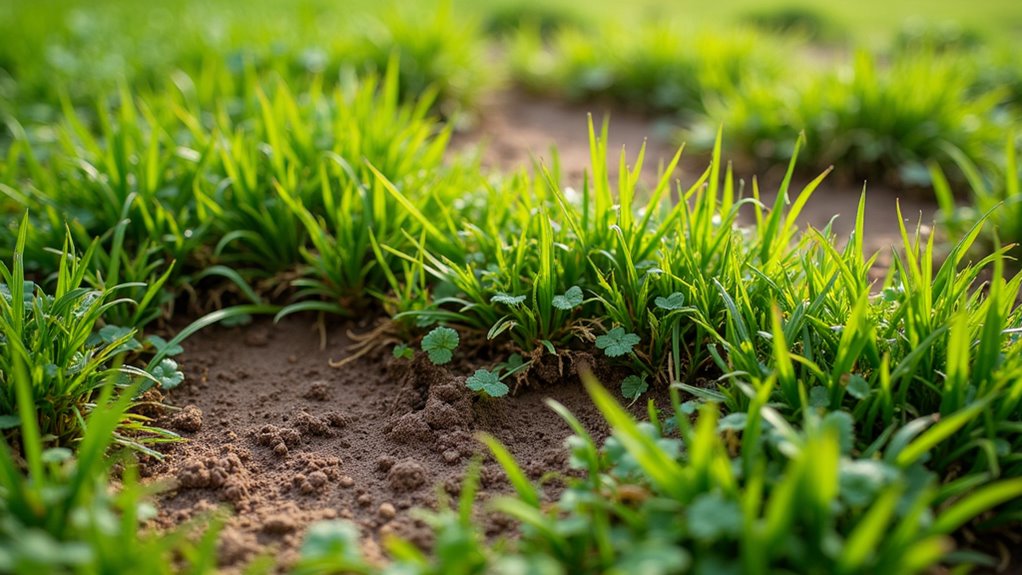
If you’re noticing an uptick in weeds throughout your lawn, it’s likely signaling a critical nutrient deficiency that’s preventing your grass from naturally competing against these invasive plants. Your lawn’s susceptibility to pest infestations can also indicate inadequate nutrition, as weakened grass becomes an easy target for destructive insects and other lawn-damaging organisms. By implementing a proper fertilization program, you’ll strengthen your lawn’s root system and comprehensive health, enabling it to naturally resist both weed encroachment and pest invasions.
Weeds Signal Nutrient Deficiency
Persistent weeds taking over your lawn serve as a clear warning sign of underlying nutrient deficiencies. When your grass lacks essential nutrients, it creates ideal conditions for opportunistic weeds to establish themselves and flourish at the expense of your turf’s health.
To understand how weeds indicate your lawn’s nutrient status, consider these key factors:
- Weeds naturally outcompete grass in nutrient-poor soil conditions
- Your lawn’s inability to resist weed invasion suggests weakened root systems
- Accelerated weed growth often correlates with specific mineral deficiencies
- Dense weed populations indicate your grass can’t maintain competitive advantage
Pest Invasion Warning Signs
Beyond weed invasion, monitoring pest activity serves as another reliable indicator of your lawn’s nutritional health. When you notice an uptick in both weeds and pests infiltrating your turf, it’s often a clear sign that your lawn lacks essential nutrients. Pests are naturally drawn to grass that’s struggling due to poor nutrition, as these weakened areas provide easier targets for infestation.
Your lawn’s ability to fight off unwanted invaders directly correlates to its nutritional status. When your grass has adequate nutrients, it develops natural resistance mechanisms against both weeds and pests. However, nutrient-deficient lawns can’t effectively compete with aggressive weeds or ward off destructive insects. If you’re seeing increased pest activity alongside persistent weed problems, it’s time to implement a strategic fertilization program to strengthen your lawn’s natural defenses.
Strengthening Natural Weed Resistance
While many homeowners resort to reactive treatments against weeds and pests, strengthening your lawn’s natural defenses through proper fertilization offers a more effective long-term solution. Your lawn needs adequate nutrition to maintain its competitive edge against invasive species.
When your lawn needs fertilizer, you’ll notice increased vulnerability to weed and pest invasions. To fortify your grass’s natural resistance:
- Apply balanced fertilizer containing nitrogen, phosphorus, and potassium to develop sturdy root systems
- Maintain consistent fertilization schedules to promote dense grass growth that crowds out weeds
- Monitor nutrient levels through soil testing to prevent deficiencies that weaken natural defenses
- Implement strategic fertilization during peak growing seasons when grass actively competes with weeds
This proactive approach helps create a resilient lawn that naturally suppresses both weed growth and pest infestations.
Thin Patches and Bare Spots
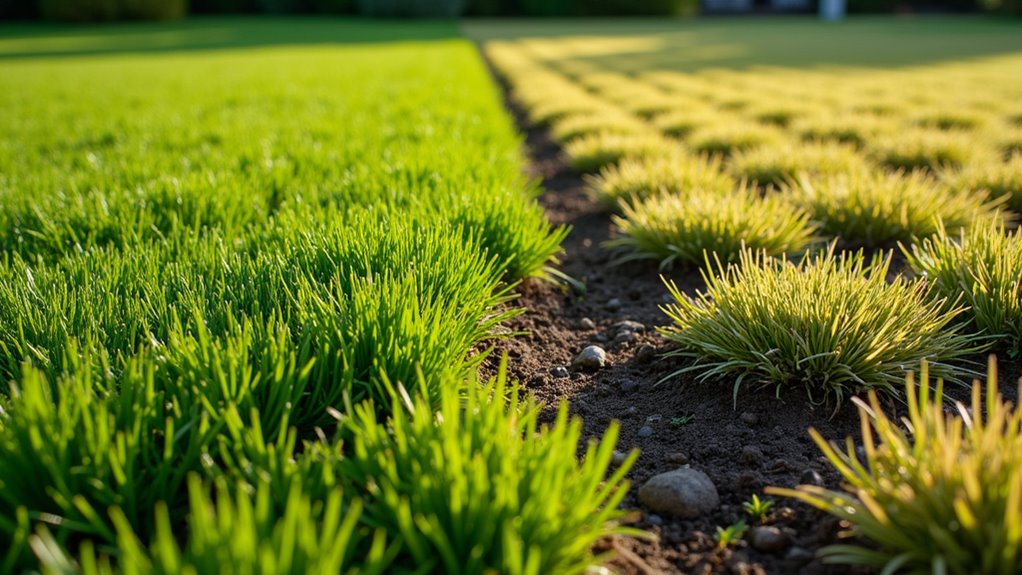
When you notice thin patches and bare spots scattered across your lawn, you’re likely witnessing signs of nutrient deficiency that’s preventing proper grass coverage. These weakened areas typically indicate poor root system development, as grass plants can’t establish strong networks underground without adequate nutrition. You’ll often find these compromised spots are more susceptible to environmental stress and slower to recover from damage, making fertilization essential for restoring healthy growth patterns.
Spotting Nutrient-Poor Areas
Looking across your lawn, you’ll often find telltale signs of nutrient deficiency in areas that appear patchy, thin, or completely bare. These problematic spots indicate your soil likely lacks essential nutrients required for healthy grass growth.
To effectively identify nutrient-poor areas in your lawn, watch for these key indicators:
- Sparse grass growth with visible soil between blades
- Irregular patches where grass fails to establish or maintain growth
- Areas that remain thin despite adequate watering
- Sections that don’t respond to regular maintenance
A professional soil test will pinpoint specific nutrient deficiencies, allowing you to select the right fertilizer for your lawn’s needs. Understanding these deficiencies is pivotal, as applying the correct balance of nitrogen, phosphorus, and potassium will help restore uniform growth and density to your lawn.
Root System Weakness
Because weak root systems often manifest as thin patches and bare spots in your lawn, identifying these trouble areas can reveal underlying nutrient deficiencies. When your lawn needs essential nutrients like nitrogen, phosphorus, and potassium, the root system can’t develop properly, leading to visible deterioration across the grass surface.
To determine if poor root development is the culprit, you’ll want to conduct a soil test. This analysis will pinpoint specific nutrient imbalances that are compromising your lawn’s foundation. Once you’ve identified the deficiencies, targeted lawn fertilization can strengthen the root system. Applying a balanced fertilizer will provide the necessary nutrients to improve root growth, eventually helping your grass fill in those thin areas and restore a healthy, dense appearance.
Understanding Your Soil Test Results
After receiving your soil test results, you’ll need to interpret several key measurements to determine your lawn’s fertilizer requirements. Understanding the analysis will help you select the right nutrients for your specific Soil Types and conditions.
Soil test analysis guides smart fertilizer choices, ensuring your lawn gets exactly what it needs for optimal growth and health.
Your test results will reveal these critical factors:
- pH level – Indicates soil acidity or alkalinity, affecting nutrient availability
- Nitrogen (N) content – Essential for leaf growth and vibrant green color
- Phosphorus (P) levels – Critical for root development and energy transfer
- Potassium (K) content – Crucial for disease resistance and drought tolerance
Focus on addressing deficiencies shown in your results. If phosphorus levels are low but nitrogen is adequate, choose a fertilizer with a higher middle number in the N-P-K ratio. This targeted approach guarantees you’re applying only the nutrients your lawn actually needs.
Seasonal Nutrient Requirements
Your lawn’s nutrient needs follow a predictable seasonal pattern that you’ll need to monitor throughout the growing season. You should apply an early spring fertilizer to strengthen roots, maintain steady feeding through the high-growth period of late spring, and adjust nutrients during summer to help your grass cope with heat stress and heavy use. Fall fertilization is pivotal as your lawn recovers from summer damage and prepares for winter dormancy, making this an indispensable time to replenish depleted nutrients.
Spring Feeding Guidelines
Spring marks the pivotal period for fertilizing your lawn, typically between February and April when grass begins to green up and actively grow. During this essential time, your lawn care strategy should focus on strengthening root systems and preparing grass for the growing season ahead.
To maximize your spring fertilization efforts:
- Choose an early-spring formulated fertilizer like Scotts® Turf Builder® that includes both crabgrass and broadleaf weed prevention
- Apply fertilizer when you notice the first signs of grass greening up
- Focus on supporting root development, as strong roots will sustain your lawn’s increasing energy demands
- Time your application to help your lawn recover from winter stress while preparing for peak growth
This strategic approach to spring feeding establishes the foundation for a sturdy, healthy lawn throughout the growing season.
Summer Nutrient Demands
While spring fertilization builds the foundation, summer presents unique challenges that demand a specialized approach to lawn nutrition. Your lawn faces increased stress from heat, drought, foot traffic, and insects during this time, making proper fertilization between June and August indispensable.
You’ll need to help your grass meet these heightened nutrient demands with specific summer-formulated products. If you’re in the North, apply Scotts® Healthy Turf Builder® Fungicide and Lawn Food to combat both nutrient deficiencies and fungal issues. For Southern lawns, Scotts® Turf Builder® Summer Lawn Food provides essential nutrients. Alternatively, Scotts® Turf Builder® SummerGuard® Lawn Food with Insect Control offers comprehensive protection and nourishment. By maintaining proper summer fertilization, you’ll enable your lawn to recover from stress and prepare for the upcoming fall season.
Fall Fertilizing Schedule
As temperatures begin cooling in September, fall fertilization becomes essential for strengthening grass roots and storing critical nutrients before winter dormancy. The right time to fertilize your lawn during autumn follows a strategic schedule that optimizes nutrient absorption and promotes healthy spring growth.
- Apply the primary fall fertilizer application in early September using a high-nitrogen formula to stimulate root development and recovery from summer stress
- Schedule a second feeding in early October with a balanced NPK ratio to support continued root growth
- Make your final application in late November using a high-potassium winterizer formula to boost cold hardiness
- Adjust timing based on your specific grass type and local climate zone, as warm-season and cool-season grasses have different fall nutrient requirements
Common Nutrient Deficiency Symptoms
When your lawn displays certain telltale signs, it’s likely suffering from specific nutrient deficiencies that require fertilization. You’ll notice your grass needs attention when growth becomes sluggish and the color fades to yellow, indicating insufficient nitrogen levels. These symptoms, combined with increasing weed invasion and pest problems, signal that your lawn isn’t getting adequate nutrients.
Watch for thinning areas or bare patches in your turf, as these indicate your soil may be lacking essential elements like phosphorus and potassium. To accurately diagnose these deficiencies, conduct a soil test – it’ll reveal specific nutrient imbalances and guide you in the direction of the right fertilizer solution. The test results will help you select the appropriate fertilizer blend and determine how frequently you should apply it to restore your lawn’s health.
Proper Timing for Fertilizer Application
Proper fertilizer timing can make the difference between a thriving lawn and wasted effort. For Healthy Turf, you’ll need to follow a strategic fertilization schedule throughout the growing season. It’s time to fertilize your lawn during these key periods:
- Early spring (February-April) – Apply when grass begins to green up and show active growth patterns
- Late spring (April-June) – Feed your lawn while it’s utilizing stored energy reserves
- Summer (June-August) – Support your grass through heat stress, drought, and heavy use
- Fall (August-November) – Help your lawn recover and prepare for winter dormancy
For northern lawns, apply Scotts® WinterGuard® twice in fall. Southern lawns benefit from either Scotts® Bonus® S Southern Weed & Feed2 or WinterGuard® Fall Weed & Feed3 during the autumn months.
Regional Considerations for Fertilizing
Different regions require distinct fertilization approaches based on climate patterns, grass types, and growing seasons. In Northern regions, you’ll need to focus on late spring applications using Scotts® Turf Builder® Weed & Feed5 or standard lawn food, followed by two fall applications of WinterGuard® Fall Lawn Food to guarantee your lawn the nutrients it requires.
Southern lawns have different regional considerations, requiring Scotts® Turf Builder® Southern Lawn Food in late spring and specialized weed and feed products in fall. Summer care varies by region too – Northern lawns benefit from SummerGuard® with Insect Control or fungicide-enhanced food, while Southern lawns need Summer Lawn Food. Following a region-specific lawn care plan safeguards your grass receives appropriate seasonal nutrition. These targeted approaches account for varying climate conditions and grass types unique to each geographical area.
Choosing the Right Fertilizer Type
Selecting the perfect fertilizer type requires understanding the key nutritional components represented by the N-P-K ratio on fertilizer labels. Each number indicates the percentage of nitrogen, phosphorus, and potassium, helping you choose the fertilizer that’s right for your lawn’s specific needs.
Consider these essential options when selecting from different types of lawn fertilizers:
- Slow-release fertilizers: Provide sustained nutrition over months, suitable for consistent growth
- Fast-release fertilizers: Deliver immediate results when your lawn needs a quick nutrient enhancement
- Organic fertilizers: Improve soil structure while supplying gradual nutrition from natural sources
- Specialty weed-and-feed products: Combine fertilization with targeted weed control
Your soil test results will determine which formulation best addresses your lawn’s deficiencies, ensuring optimal nutrient delivery and healthy growth.
Frequently Asked Questions
What Does Grass Look Like When It Needs Fertilizer?
Your grass will show distinct signs when it needs fertilizer. You’ll notice a wilting appearance even with adequate water, and discolored blades that appear yellowish or pale green rather than vibrant. The lawn’s growth will be noticeably slower than usual, and you’ll spot thin or bare patches developing. Watch for increased weed invasion taking over weak areas. These visual indicators strongly suggest your grass is lacking essential nutrients.
When Should You Put Fertilizer on Your Lawn?
For ideal fertilizer application timing, you’ll need to follow a seasonal lawn maintenance schedule. Apply your initial treatment in early spring (February-April) when grass begins growing. Follow up with a late spring application (April-June), then a summer treatment (June-August) to combat stress. Ultimately, apply fall fertilizer (August-November) to prepare for winter. Always perform a soil test first to determine your lawn’s specific nutrient needs.
What Happens if You Don’t Fertilize Grass?
If you don’t fertilize your grass, you’ll experience gradual nutrient depletion in your soil, leading to weakened root systems and deteriorating lawn health. Your grass will become more susceptible to disease, weeds, and pest invasions. You’ll notice organic matter decline, resulting in poor soil structure and reduced microbial activity. Your lawn will likely develop yellowing patches, thin areas, and stunted growth. Eventually, your grass will struggle to maintain its density and vibrant green color.
How Do I Know if My Lawn Is Nitrogen Deficient?
You’ll notice several clear signs if your lawn is nitrogen deficient. The most obvious indicator is lawn color changes, where your grass turns from deep green to a yellowish-green or yellow hue. You’ll also observe a slow growth rate, meaning you won’t need to mow as frequently. Moreover, your lawn will appear thin and patchy, with less dense grass coverage. These symptoms together provide a reliable diagnosis of nitrogen deficiency in your turf.


